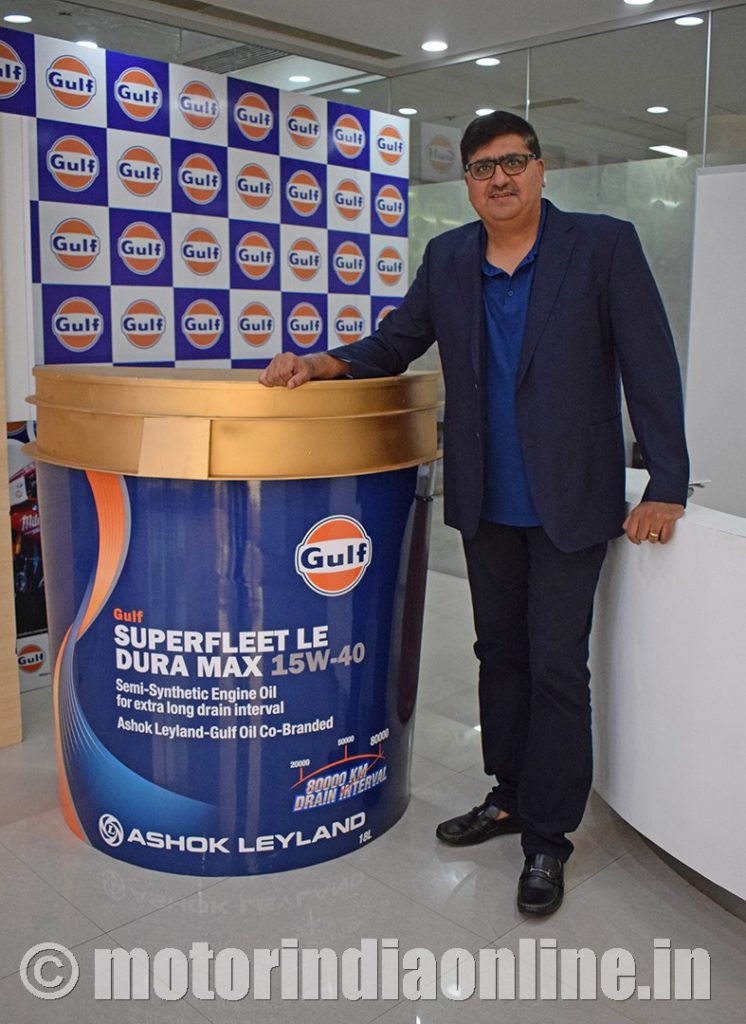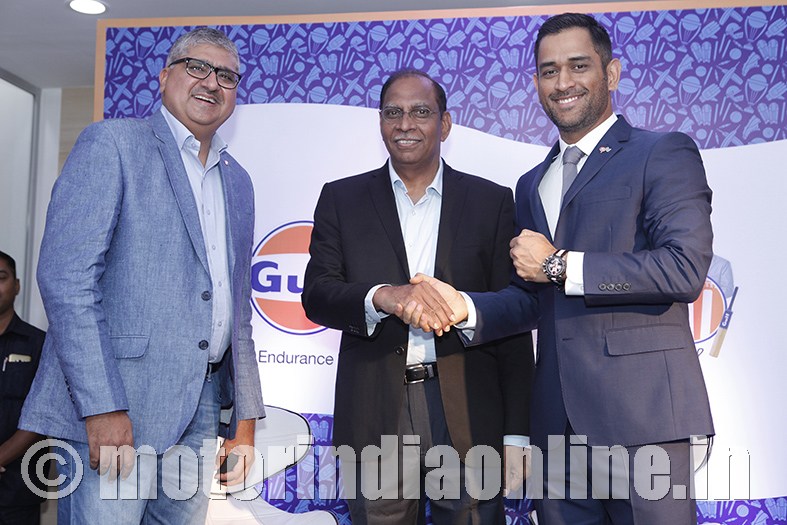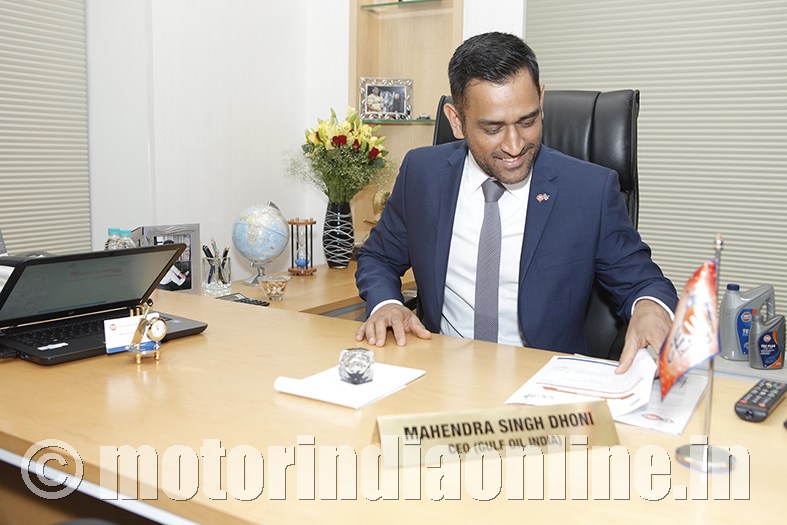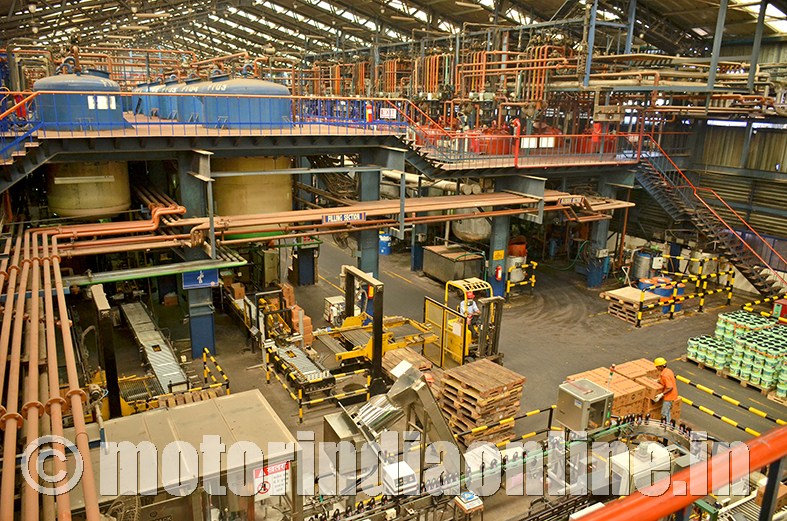In recent years, through its brand strength and aggressive market approach, Gulf Oil has emerged as the fastest growing private sector lubricant brand in India. It is not difficult to gauge the sense of the three-pronged strategy that Gulf Oil has adopted. It is a process, that has been followed for many years now, and the result is the brands consistent growth.
“Our commitment to provide world-class products to our clients through an in-depth understanding of their relevant business requirements and then consistently delivering innovative solutions and services that exude Quality, Endurance and Passion helps us achieve constant growth. We have been growing at a CAGR of 11 per cent which is 2-3 times that of the market and remain focused on our communication process to imbibe the value of our brands in our customers,” explained Mr. Ravi Chawla, Managing Director, Gulf Oil Lubricants India Ltd.

Extended oil drain intervals
Leveraging its global technology, to provide extended oil drain intervals to the OEMs, Gulf Oil began its journey in India with OE tie-ups in 2006. In the last 11 years, the company has formed strong partnerships with manufacturers like Ashok Leyland, BharatBenz, Volvo Penta, Mahindra & Mahindra, Schwing Stetter, Bajaj, etc. “Whenever we have done an OEM partnership we had validated our products in their engines/equipment for around 12-18 months under various operating conditions in India, keeping in mind the long drain intervals the OEM is intending to achieve. Since every engine is different, every oil should be fine-tuned and formulated as per the vehicle application,” said Dr. Y.P. Rao, Chief Technology Officer, Gulf Oil International.
When Gulf Oil pioneered the concept of long-drain diesel engine oils for commercial vehicles in India in 2006, the drain intervals were at 15 to 18,000 km. BS-III was just a year old. They brought the long drain interval oils after thorough evaluation on vehicles in intra-city, inter-city and doubled the oil drain intervals for diesel engines up to 36,000 km co-branding it with Ashok Leyland.
“In 2010, we had introduced yet another extra-long life engine oil with a drain interval of 80,000 km by following the similar validation process. We even increased the drain intervals of gear and axle oils which were at 40 to 50,000 km to 1,20,000 and 80,000 km respectively to extend the service intervals, so that vehicles make less trips to workshops,” disclosed Dr. Rao.
To further understand the need for long drain intervals, one must look at the global scenario. Europe, with its use of synthetic and semi-synthetic engine oils, has a drain interval of between 1,20,000 and 1,50,000 km. The US market also is almost close to 80,000 km. “India which is currently at 60% of the European standard will have to adapt to the improved mineral oils and additive technology as the country plans to move to BS-VI by 2020,” explained Dr. Rao. Performance enhancing additives and base stocks, classified under Group 1, 2 and 3, help formulate the lubricants.

“We use carefully selected, severely hydrocracked base stocks in combination with the latest additive technology that gives us the performance edge, enabling us to deliver the long drain interval oils to the market,” said Mr. Chawla.
Today, engines are expected to operate at higher temperatures to achieve improved fuel economy. For better fuel economy and less pollution, lubricants are offered in lower viscosity grades. Does the rise in drain intervals also means double the price for the product? He added: “When you are offering a value proposition the price is certainly premium. So anything from 15-20 per cent premium is definitely justifiable as the customers are getting double the benefit they were earlier getting.”
Emission norms & expansion
BS-IV and BS-VI will require a completely new type of engine oils with controlled SAPS (Sulphated Ash, Phosphorous, Sulphur), from what are being marketed and sold today. “Change in emission norms will require a different type of aftertreatment systems. For instance, in today’s BS-IV, M&HCVs, vehicle manufacturers are using Selective Catalytic Reduction (SCR) or EGR to reduce NOx. Besides SCR and EGR, BS-VI vehicles will also require Diesel Particulate Filter (DPF) and Diesel Oxidation Catalyst (DOC),” beamed Mr. Rao.
He further added: “Gulf Oil International has obtained approvals from leading global OEMs and is already supplying lubricants for the Euro VI vehicles in Europe. In India, at any given point of time our lubricants undergo testing in around 150 equipment / vehicles. This helps us to generate extensive data on different oil technologies providing us insight into the requirements of different engines / equipment, which enables us to formulate oils that exceed the stringent OEM requirements in terms of equipment protection, drain intervals, etc. It is relatively easier for us given our global experience, and we need to customize the oil formulation to Indian conditions and are in a favourable position to do so.”
To help the vehicle meet the BS-IV and BS-VI emission standards, AdBlue, a registered trademark of VDA of Germany and licensed to companies that conform to the ISO 22241-1 to 4 specifications like Gulf Oil, is used. AdBlue is an extremely pure solution, especially developed for diesel engines with a SCR system of emission control. It mainly consists of demineralized pure water and high quality 32.5 per cent automotive grade urea. It is injected into exhaust gas to reduce harmful NOx emissions to meet the BS-IV / Euro IV (& higher) emission standards. It is also known as diesel exhaust fluid (DEF) in North America. “SCR will need urea in the form of AdBlue and BS-VI vehicles will need the combination of EGR, SCR, DOC and DPF (diesel particulate filters),” reiterated Mr. Rao.
Gulf Oil is currently having over 30 per cent of market share in AdBlue. It has set up a dissolution unit at its lubricant plant in Silvassa and is expected to add another unit at its new lubricant blending plant under construction in Chennai to meet the rapidly growing demand.
The current lubricant plant that has an overall capacity of 90,000 kl per year at Silvassa will be complemented by a new blending plant in Chennai with an annual capacity of 40,000 kl which is scheduled to start commercial production in the third quarter of the current financial year.
Gulf’s Indian operations are spread nationwide with more than 350 distributors, over 55,000 retailers and over 200 sales and technical service personnel. “We already supply Adblue to OEMs and large consumers directly as well as through our retail network. Our strategy is to grow our distribution higher than our volumes,” Mr. Chawla disclosed.
Engaging people
Given the fact that at any point vehicles and equipment are at stake due to the performance expected out of them, Gulf Oil relies on engaging consumers through the OEM & mechanics, dealers and the distributors who are the product promoters. One such activity was the Gulf campaign ‘Gulf On Toh Tension Gone’. “It turned out to be a mega BTL campaign in the commercial vehicle segment and one amongst Gulf’s biggest-ever campaigns in terms of scale and reach,” exclaimed Mr. Chawla.
Under this campaign, in under two months, 29 cities & 45 Transport Nagar were covered. The campaign touched 3000 plus retailers, and more than 4000 retail outlets were branded with Gulf point of sales merchandise like Banners, Posters, Product Z Cards, product recommendation charts, etc. It also fetched the company 12000 plus contacts covering CV mechanics, drivers and owners. Apart from this, oil-change camps were rolled out across 8 agri-focused States, and it received a massive response with 11000 plus tractor owners changing their engine oil with Gulf farm range engine oils.
Brand Gulf has also enjoyed prominent and prolonged visibility on TV, digital and on-ground as the cricket team it partnered for IPL, Rising Pune Supergiants reached the finals of this popular T20 tournament. A unique event, Gulf “CEO – DAY”, was also organized on the occasion when the Gulf Brand Ambassador M.S. Dhoni became CEO for a day and addressed, interacted and motivated the employees and the management team. He shared his thoughts on leadership, targeting higher growth, etc.
Such events are result-oriented. “We have gained market share and currently 45 per cent of our sales comes from diesel engine oils including CVs, tractors and construction equipment. 20 per cent from motorcycle oils which was only less than 10 per cent in 2007. 4-5 per cent sale comes from passenger cars and remaining we also supply to infrastructure developers such as Shapoorji Pallonji, L&T Constructions, etc., industrial greases, marine oils, cylinder oils, metal working, textile and cement segment,” concluded Mr. Chawla.


